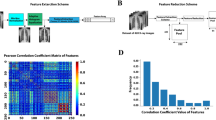Abstract
An important task in combating COVID-19 involves the quick and correct diagnosis of patients, which is not only critical to the patient’s prognosis, but can also help to optimize the configuration of hospital resources. This work aims to classify chest radiographic images to help the diagnosis and prognosis of patients with COVID-19. In comparison to images of healthy lungs, chest images infected by COVID-19 present geometrical deformations, like the formation of filaments. Therefore, fractal dimension is applied here to characterize the levels of complexity of COVID-19 images. Moreover, real data often contains complex patterns beyond physical features. Complex networks are suitable tools for characterizing data patterns due to their ability to capture the spatial, topological and functional relationship between the data. Therefore, a complex network-based high-level data classification technique, capable of capturing data patterns, is modified and applied to chest radiographic image classification. Experimental results show that the proposed method can obtain high classification precision on X-ray images. Still in this work, a comparative study between the proposed method and the state-of-the-art classification techniques is also carried out. The results show that the performance of the proposed method is competitive. We hope that the present work generates relevant contributions to combat COVID-19.
Access this chapter
Tax calculation will be finalised at checkout
Purchases are for personal use only
Similar content being viewed by others
References
Huang, C., et al.: Clinical features of patients infected with 2019 novel coronavirus in Wuhan, China. Lancet 395, 497–506 (2020)
Majunder, M.S.; Mandl, K.D.: Early transmissibility assessment of a novel coronavirus in Wuhan, China. SSRN (2020)
Zhao, S., et al.: Preliminary estimation of the basic reproduction number of novel coronavirus (2019-nCoV) in China, from 2019 to 2020: a data-driven analysis in the early phase of the outbreak. Int. J. Infect. Dis. 92, 214–217 (2020)
Read, J.M., et al.: Novel coronavirus 2019-nCoV: early estimation of epidemiological parameters and epidemic predictions. MedRXiv (2020)
Gozes, O., et al.: Rapid AI Development Cycle for the Coronavirus (COVID-19) Pandemic: Initial Results for Automated Detection and Patient Monitoring using Deep Learning CT Image Analysis. arXiv2003.05037 (2020)
Hofmanninger, J., Prayer, F., Pan, J., Röhrich, S., Prosch, H., Langs, G.: Automatic lung segmentation in routine imaging is a data diversity problem, not a methodology problem. https://arxiv.org/abs/2001.11767 (2020)
Yee, S.L.K., Raymond, W.J.K.: Pneumonia diagnosis using chest X-ray images and machine learning. In: Proceedings of the 2020 10th International Conference on Biomedical Engineering and Technology, (ICBET 2020), pp. 101–105. Association for Computing Machinery, New York (2020). https://doi.org/10.1145/3397391.3397412. ISBN 9781450377249
Mandelbrot, B.: How long is the coast of Britain? Statistical self-similarity and fractional dimension. Science 156, 636–638 (1967)
Falconer, K.: Fractal Geometry: Mathematical Foundations and Applications. Wiley, Chichester (2003)
Finkel, R.A., Bentley, J.L.: Quad trees a data structure for retrieval on composite keys. Acta Informatica 4, 1–9 (1974). https://doi.org/10.1007/BF00288933
Silva, T.C., Zhao, L.: Network-based high level data classification. IEEE Trans. Neural Netw. Learn. Syst. 23, 954–970 (2012)
Watts, D.J., Strogatz, S.H.: Collective dynamics of ‘small-world’ networks. Nature 393, 440–442 (1998). https://doi.org/10.1126/science.286.5439.509
Barabasi, A.-L., Albert, R.: Emergence of scaling in random networks. Science 286, 509–512 (1999). https://doi.org/10.1126/science.286.5439.509
Albert, R., Barabasi, A.L.: Statistical mechanics of complex networks. Rev. Mod. Phys. 74, 47–97 (2002). https://doi.org/10.1103/RevModPhys.74.47
Newman, M.E.J.: The structure and function of complex networks. SIAM Rev. 45, 167–256 (2003). https://doi.org/10.1137/S003614450342480
Barabási, A., et al.: Network Science. Cambridge University Press, Cambridge (2016)
Silva, T.C., Zhao, L.: High-level pattern-based classification via tourist walks in networks. Inf. Sci. 294, 109–126 (2015)
Silva, T.C., Zhao, L.: Machine Learning in Complex Networks. Springer, Cham (2016). https://doi.org/10.1007/978-3-319-17290-3. https://www.springer.com/gp/book/9783319172897. ISBN 9783319172897
Carneiro, M.G., Zhao, L.: Organizational data classification based on the importance concept of complex networks. IEEE Trans. Neural Netw. Learn. Syst. 29, 3361–3373 (2018)
Colliri, T., et al.: A network-based high level data classification technique. In: 2018 International Joint Conference on Neural Networks (IJCNN), pp. 1–8 (2018)
COVID-19 Radiography Database. https://www.kaggle.com/tawsifurrahman/covid19-radiography-database. Accessed 4 Feb 2021
Estrada, E., Hatano, N.: Communicability in complex networks. Phys. Rev. E 77, 036111 (2008). https://doi.org/10.1103/PhysRevE.77.036111
Acknowledgment
This work is supported in part by the Sao Paulo Research Foundation (FAPESP) under grant numbers 2015/50122-0, the Brazilian National Council for Scientific and Technological Development (CNPq) under grant number 303199/2019-9, and the Ministry of Science and Technology of China under grant number: G20200226015.
Author information
Authors and Affiliations
Corresponding author
Editor information
Editors and Affiliations
Rights and permissions
Copyright information
© 2022 The Author(s), under exclusive license to Springer Nature Switzerland AG
About this paper
Cite this paper
Liu, W. et al. (2022). Analysis of Radiographic Images of Patients with COVID-19 Using Fractal Dimension and Complex Network-Based High-Level Classification. In: Benito, R.M., Cherifi, C., Cherifi, H., Moro, E., Rocha, L.M., Sales-Pardo, M. (eds) Complex Networks & Their Applications X. COMPLEX NETWORKS 2021. Studies in Computational Intelligence, vol 1072. Springer, Cham. https://doi.org/10.1007/978-3-030-93409-5_2
Download citation
DOI: https://doi.org/10.1007/978-3-030-93409-5_2
Published:
Publisher Name: Springer, Cham
Print ISBN: 978-3-030-93408-8
Online ISBN: 978-3-030-93409-5
eBook Packages: EngineeringEngineering (R0)




